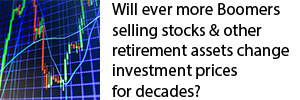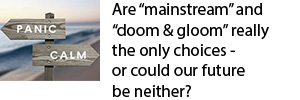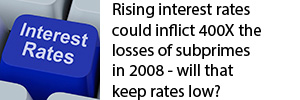The Eight Energy Systems Driving The Stock Market Rout
by Daniel R. Amerman, CFA
TweetThe energy systems which drove the global stock market rout have been building for months and years, and by the spring of this year, the danger flags were clearly flying. Indeed, as I wrote in May of 2015 in an analysis titled "A Financial "Perfect Storm" May Be Brewing" (link here):
"In the financial world at this very moment, we have eight different "weather systems" that are all developing in real time.
... if several of the more powerful components were to converge – and reinforce each other – then we could very rapidly reach the point of greatest financial instability that the world has seen since 2008."
"a previously relatively boring radar map has been replaced by surging energy and a multiplying array of new systems. ... a rapidly evolving situation has come into existence where an event of historic magnitude is entirely possible, and it can happen with great speed."
Most of the latent energy has not yet been released, but is still there. This makes it highly worthwhile to revisit these eight sources of "energy", see what has been set off, and what may yet be released as part of this storm or another to follow.
The first seven section titles are the same as the original article, with text from that analysis in italics, and with updated contents based upon the current situation in normal typeface.
1) Very Low Interest Rates
We still have very low interest rates, and indeed, a further cut in interest rates has been a key part of the response by the Chinese government to the deepening crisis.
Also of particular interest is that the day of the market reversal of August 26th, when six straight days of losses were broken, the headlines were about Federal Reserve Bank of New York President William Dudley stating that the case for a September rate hike was "less compelling".
Pervasive very low interest rates that have been created by governmental interventions around the world are the defining difference between the current correction / bear market (depending on the nation), and previous corrections and bear markets. Asset prices, investor behavior, and currency conflicts, as individually covered below are all tightly linked to this one central component.
Indeed, it is artificially low interest rates that is both the crisis dampener as well as the central source of energy for crisis. An endless supply of cheap money props up markets even while the dysfunctional side effects of that flood of money increases the fundamental pressures on the same markets.
2) Artificially Elevated Asset Prices
"As explored in my recent article, "Mazes, Mice And Investor Perception Management" (link here), one of the several intentions behind forcing these very low interest rates has been to drive asset prices upwards, thereby creating artificially high market prices in the hopes of generating a "wealth effect" that is intended to change investor behavior and stimulate the economy. The economic stimulation has not occurred, but a fundamental mismatch has been created around the globe between overpriced bonds and equities, and what can be justified by the underlying fundamentals."
Driving equity prices to artificially high levels in an attempt to deliberately stimulate the economy is and always has been a high risk strategy. This is one of the primary sources of energy driving the current decline in US stock prices.
The "band-aids" that at least temporarily stopped the stock rout in the US and China were each based on central banking actions. China lowered interest rates while lowering reserve requirements, and the Fed at least temporarily appeared to back off from a long threatened small increase in interest rates. These actions are intended to stabilize - but at a steep price. For the cost of the central banking actions is to increase the "over-valuation" and the risk.
That's really the point. Governments intervene in markets because they don't like the natural outcomes, and in this case, don't want prices to go where the market would otherwise take them. However, so long as market prices are pushed to artificially high levels by government interventions, then there is a continuous source of tension and energy, as there is always the danger that the mispricing which has been so intentionally created will be accidentally corrected in a market plunge.
The stock market rout of August, 2015 was a partial release of energy. However, so long as the fundamentals are out of line with prices, then a new and potentially much larger decline is a continuous possibility. This was true before August, it remains true at current levels, and if market prices rebound further - then the energy waiting to be released will be increased right along with the rebound.
3) Developing Fears Of A Liquidity Crunch
"As stated in a recent speech by Steven Maijoor, chairman of the European Securities and Markets Authority (ESMA), global central banking actions including quantitative easing and other forms of unconventional monetary policy have created the risk of a liquidity crunch. The central banks have created risks of "over-valuation" in the bond and equity markets that are "considerable", and are "raising risks for the non-banking sector".
And when liquidity is an issue, a shift in investor sentiment that could otherwise be easily contained in a large and healthy market can instead set off a stampede for the exits, which can dramatically change markets overnight – possibly in a matter of minutes or hours."
The head of the European Securities and Markets Authority was publicly warning in May that central banking actions had created over-valued equity markets that resulted in considerable risks. What is happening now is not a blindside, it isn't unexpected, and it has very little to do with most historical stock market plunges and corrections.
There are two critical implications for the coming days and months. One is that what Mr. Maijoor warned of did happen in practice, but not on a major scale. Yes, a 1,000 point intraday loss in the Dow that was fed by massive selling and very few buyers was scary, but it could have been much worse. What happened confirmed the reality of the danger, but was far from a worst case scenario.
The second issue is that the bond market acted as a safe haven for the stock market in August, as investors fleeing stocks drove bond prices upwards. But this result does not reduce the liquidity crunch dangers within the bond market, which are arguably even greater than those within the stock market.
The stock market has far more diversity among the types of stocks, than does the bond markets, particularly when looking at government bonds. If everyone believes that interest rates are rising and bond prices will be plunging - then who is it who steps up to buy? Other than central banks - what is the source of liquidity?
The heart of the problem is that the stock market rout was stopped by what could be called bond market interventions, to the extent that interest rates and monetary creation (through changing reserve requirements in China) were the tools used. This worked because the institutional investors accept that stock market prices can be propped up by cheap money, which is no surprise, given that it is the underlying story of modern markets.
However, if the next crisis starts in the bond market, this means that the stock market is unlikely to act as the safe haven, but is more likely to be a crisis multiplier. For a plunge in the bond markets simultaneously imperils the current support propping up the stock markets. Because this is so well understood by institutional investors, this means that a future rout in the bond market could almost instantly flash into a stock market rout, as liquidity evaporates in both markets simultaneously.
Because the solution to the stock market rout was to increase the fundamental pressure on bond prices and interest rates, this means that the result of the August 2015 correction was arguably not to reduce the chances and size of an extreme liquidity event, but rather to increase the latent energy waiting to be released.
4) A Current Global Bond "Rout"
First, we need to keep in mind that despite its recent frequent usage by the mainstream financial media - the term "rout" is a relative one. Yes, we have over the last ten days or so seen some of the largest and most rapid price shifts in global bond markets in some years, and when we compare this to the artificial placidity of government and central bank-dominated bond markets of the recent past, this is a remarkable rout. From a longer term historical perspective we're still not there yet – but a global sell-off is in process, and this combination of circumstances could yet get us to the real thing.
While the August stock market rout was no record breaker on a global scale (at least so far), it was much closer to being a real "rout" than what we saw in the bond markets on a global scale in the spring.
The important information value is that we now have global confirmation in both markets, stocks and bonds, that the grip of the central banks is running into issues. And investors know it.
5) The Dangerous Combination Of Falling Bond Prices & Bond ETFs
"Much of the financial markets have transformed since 2008, and while the emphasis by regulators has been on "fighting the last war" by attempting to reduce bank risks, in many ways total risk is higher than ever – but it's just been transferred to other places.
...If markets correct to more rational levels, and investors in large numbers head for the exits to get out of bonds, and this leads to massive quantities of forced sales to get the money to make the redemptions, and this happens in a thin market where buyers have evaporated – then we have a near perfect recipe for a financial storm of extraordinary magnitude, and which could develop with blinding speed."
In some ways the current stock market rout is one of the first major tests of how ETFs change investor outcomes during crisis. And as reported on the front page of the Wall Street Journal there was an almost immediate and major failure to perform, with stock ETFs multiplying the losses for investors compared to if they had been invested directly in the underlying stocks.
One example was the Vanguard Consumer Staples ETF trading at a loss of 32% while the underlying holdings fell 9%. Another example was stop-loss orders for the iShares Core U.S. Value ETF, which were supposed to be executed at the 14% down level, being actually executed at 31% down, because of a fast moving market with a lack of buyers. Thinner markets mean larger and more frequent gaps, even with the so-called "circuit-breakers" of automatic trading halts in place.
To date, we have only seen a small portion of the potential risk from ETFs. The bond ETFs which have not yet been tested, are likely to be at higher risk in a crisis than the stock ETFs. With the largest risk being that the true stress test on both bond and stock ETFs could occur simultaneously.
6) A Potential Sea Change In Institutional Investor Perceptions And Behavior
"One of the key underpinnings of market stability in recent years has been an effective "retraining" of institutional investors.
...we are seeing investors moving against the central banks in large numbers for the first time in years. Which shows a very real fear on their part that the central banks could lose control of their artificial stability.
This is a particularly serious danger because it can be a self fulfilling prophecy, where compliant and trained investors who were the source of much of the previous stability are now behaving more independently. This danger of 1) a major source of stability not only being lost but being flipped into 2) a major source of instability can acutely exacerbate financial stability risk – particularly in the environment with the other risks previously described."
Changes in institutional investor perceptions are both the largest market risk, and where the greatest increase in stored energy occurred as a result of the August stock market rout. As covered in much more detail in my "Profiting From Government-Dominated Markets" video course, major investors accepting the dominance of governmental interventions over fundamental valuations has been the central story of the markets in the 2010s to date. Neither stock prices, bond prices, precious metals prices or real estate prices can be fully understood without a thorough comprehension of this fundamental source of current market valuations.
So long as the most sophisticated investors accept effective governmental control of markets, then a symbiotic relationship is created. The cost of controlling markets can be very cheap for central bankers, as all they have to do is use the right words in their speeches and policy statements - and compliant investors around the world will move trillions of dollars and euros to align themselves with government wishes. These investors know it doesn't pay to fight against those who can create money by the trillions at will, but have learned that if they instead choose cooperation with those in power, then they are rewarded with profits on a more reliable basis than should exist in free markets.
However, if these major investors lose confidence in the ability of central banks to maintain control - then everything changes. These investors may seek to flee overvalued markets. To fight this flight, central banks may have to use the blunt instruments of direct monetary creation and massive market interventions. Such real world interventions can be far more difficult than merely changing the wording of policy statements, particularly as much of the available "ammunition" has already been expended with interest rates already near zero, and declining effects from quantitative easing.
With the bond market rout of the spring of 2015, and the stock market rout of the summer of 2015 - changes in institutional investor perceptions have been concretely confirmed in both markets. This means that the latent energy available to feed into future crises is the highest that it has been for years.
7) Heightened Risks From Currency Warfare
"... there is a case that a de facto currency war already exists (Bloomberg article link). That is, nations are seeking competitive advantage for their own economies by creating large sums of money in order to make their currency cheaper than other countries, meaning their exports increase and their imports decrease. The issue is that because this competition is an inherently unstable and dangerous process, currency wars can spin out of control, and quite quickly.
...Again, the "perfect storm" analogy seems to be an apt one. Deliberately pushing stock and bond prices higher than they should be creates markets that are inherently unstable. Liquidity crunches are destabilizing and dangerous. Currency warfare is destabilizing and dangerous. But what is far worse is when those three destabilizing "weather systems" not only merge together but also feed "energy" to each other and as a result they triple (or more) in strength."
It is worth remembering that the immediate trigger for the stock market rout was the surprise move by the Chinese government to devalue the yuan against the US dollar. Now, that very quickly was presented by the media as being a global concern about whether Chinese economic growth was worse than realized.
Why was this believed? Because the primary reason a nation devalues its own currency is to gain economic advantage at the expense of other nations. The world's second largest economy, which had been more or less on the sidelines recently, just launched a currency warfare offensive against the US dollar, the euro, the yen and the other currencies of the world.
Currency warfare triggered stock market instability, which created moderate but real liquidity crunch issues. The three weather system described in May did briefly converge - and the results dominated world markets.
While the downstream results of the yuan devaluation quickly overshadowed the event itself - we may still just be getting started here. If China continues to devalue the yuan - as many believe is likely - then the energy ramps up even further, and the chances of outright currency warfare increase, as do the dangers of stock and bond market instability as well as the danger of liquidity crunches, particularly with ETFs.
8) The Chinese "Trigger"
"It's also important to understand that while many view Greece to be a European problem, these "weather systems" are global in nature. That is, if Greece does "trigger" a financial crisis – that crisis won't necessarily initially manifest in Europe, and it may not happen instantly. As one possible scenario, a Greek default pushes the euro down sharply. As a defensive currency warfare measure, other nations enter into or increase their degree of quantitative easing – such as the United States, or Japan, or Australia or Canada. This then feeds the "energy", in the form of still higher asset prices and still lower liquidity. This increased instability could then quickly set off by a further deterioration in Europe, or it could be set off by something else altogether, months or years later, in an entirely different part of the world."
As mentioned, the 8th source of energy has been retitled from "Greek" to "Chinese", even as the rout moved from the bond market in the May article to the stock market in August. But the nature of the trigger does not in any way change the amount of energy in the atmosphere. China set it off in the stock market, instead of Greece in the bond market. But the energy remains.
A Radar Map That Is "Lighting Up"
"Per the International Monetary Fund, and as explored in this article (link here), modern severe financial crises can stem from the intersection of three separate but deeply intertwined risks – those of contagion risk, liquidity risk and counterparty risk.
And this "perfect storm" that is developing is starting to look like it could potentially trigger all three of these risks.
Now, does this mean a certain end of the financial world as we know it?
No.
To keep with the weather analogy, what it means is that we seem to be at that place where "high energy systems" and fronts have been popping up all over the place, and really getting those meteorologists on the Weather Channel all worked up. They can't give us a forecast with certainty, the models are conflicting, they don't know the exact storm tracks, and they don't know all the details about what is strengthening or weakening.
But what they do know is that a previously relatively boring radar map has been replaced by surging energy and a multiplying array of new systems. They know that a rapidly evolving situation has come into existence where an event of historic magnitude is entirely possible, and it can happen with great speed."
As it turns out we have seen contagion risk - in the immediate global nature of the stock market rout - as well some aspects of liquidity risk, particularly on Monday morning. But things never really kicked fully into gear, at least not so far.
The takeaway - and what makes this so different from other corrections and bear markets - is that the atmospheric energy was not released. Indeed, the radar map is still lit up from one end to another, and the colors are brighter than they were in May.
Now usually, the opposite is true with corrections and bear markets. The pressure of fundamental overvaluation is lessened by the markets moving prices downwards. So with a normal correction in normal markets, the number of systems on the radar map should decrease, and the colors grow dimmer.
But with the current situation, we still have artificially low interest rates propping up artificially high prices - with enormous latent energy waiting to be released.
The dangers of a liquidity crunch have been confirmed, as have the new dangers of ETFs during a liquidity crunch - but neither problem has been solved. So the energy is still there.
With bond and stock market routs in the span of six months - we do have solid confirmation that "the natives are restless", and the institutional investors have lost at least some of the trust in central banks that the relatively placid markets of recent years have depended upon.
We also have likely confirmation that the globe's 2nd largest economy has rejoined the currency warfare game, which dramatically increases the chances of very bad things happening. That part of the radar just went from dark green to yellow, and may yet go to red in the near future if China continues to move the yuan downwards.
All of that said, it remains true that the financial meteorologists "...can't give us a forecast with certainty, the models are conflicting, they don't know the exact storm tracks, and they don't know all the details about what is strengthening or weakening."
But we do know that the energy that became so visible earlier in 2015 is entirely real, and the radar is more crowded than ever.
 What you have just read is an "eye-opener" about one aspect of the often hidden redistributions of wealth that go on all around us, every day.
What you have just read is an "eye-opener" about one aspect of the often hidden redistributions of wealth that go on all around us, every day.
 A personal retirement "eye-opener" linked here shows how the government's actions to reduce interest payments on the national debt can reduce retirement investment wealth accumulation by 95% over thirty years, and how the government is reducing standards of living for those already retired by almost 50%.
A personal retirement "eye-opener" linked here shows how the government's actions to reduce interest payments on the national debt can reduce retirement investment wealth accumulation by 95% over thirty years, and how the government is reducing standards of living for those already retired by almost 50%.
 An "eye-opener" tutorial of a quite different kind is linked here, and it shows how governments use inflation and the tax code to take wealth from unknowing precious metals investors, so that the higher inflation goes, and the higher precious metals prices climb - the more of the investor's net worth ends up with the government.
An "eye-opener" tutorial of a quite different kind is linked here, and it shows how governments use inflation and the tax code to take wealth from unknowing precious metals investors, so that the higher inflation goes, and the higher precious metals prices climb - the more of the investor's net worth ends up with the government.
 Another "eye-opener" tutorial is linked here, and it shows how governments can use the 1-2 combination of their control over both interest rates and inflation to take wealth from unsuspecting private savers in order to pay down massive public debts.
Another "eye-opener" tutorial is linked here, and it shows how governments can use the 1-2 combination of their control over both interest rates and inflation to take wealth from unsuspecting private savers in order to pay down massive public debts.






If you find these "eye-openers" to be interesting and useful, there is an entire free book of them available here, including many that are only in the book. The advantage to the book is that the tutorials can build on each other, so that in combination we can find ways of defending ourselves, and even learn how to position ourselves to benefit from the hidden redistributions of wealth.


















